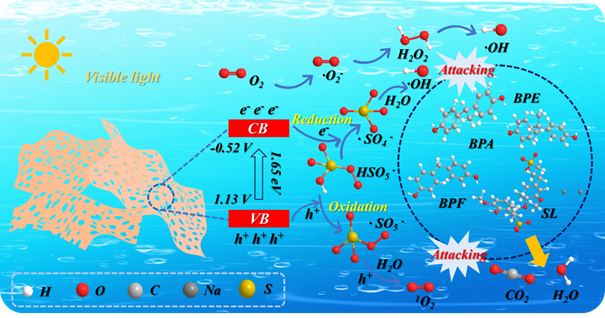Activation of peroxymonosulfate and photothermal for removal of phenolic organic pollutants and lignin derivatives
Published 02 March, 2023
The existence of endocrine disruptors and lignin derivatives can be toxic to living organisms and the environment. Inorganic non-metallic carbon nitride photothermal-catalyst can synergistically activate peroxomonosulfate to achieve efficient removal of bisphenol pollutants and lignin derivatives.
At present, the traditional ways to deal with the above two kinds of pollutants are mainly physical adsorption and biodegradation. The main disadvantages of these ways are incomplete treatment and long treatment period. Although the new photocatalytic technology uses clean energy and has mild reaction conditions, it also has the disadvantages of slow reaction speed and incomplete treatment. Compared with above ways to remove bisphenol pollutants and lignin derivatives, advanced technology to oxidize peroxymonosulfate has faster reaction rate and. However, it causes more metal ions to dissolve leading to secondary pollution to living organisms and the environment. To mitigate the issue, the ultimate solution should ideally combine photocatalytic technology and advanced peroxymonosulfate oxidation technology to eliminate the dissolution of metal ions—a team of researchers based in Canada did just that.
Researchers developed a new method for the synthesis of C-defects/C-O band-modified ultrathin porous carbon nitride, a material that has the potential to address this issue. "Carbon nitride has been widely used as a photocatalyst; however, conventional carbon nitrides have insufficient oxidizing ability and are not strong in activating peroxymonosulfate. This is largely due to their relatively small specific surface area and lack of active sites,” explained Jinguang Hu, corresponding author of the study.
Hu and his team constructed a porous ultra-thin carbon nitride material with C-defects and C-O bands using a one-step method. It can be synthesized by grinding and mixing urea nitrate, oxyacetic acid and urea evenly, and then directly thermally polymerizing in a muffle furnace. The catalyst not only increases specific surface area, but also the defect structure and doping elements to provide more active sites. Notably, the catalyst has very good photothermal performance which can accelerate the catalytic reaction process.
The team reported their study in the KeAi journal Green Energy and Environment.
"A large amount of bisphenol pollutants and lignin derivatives are constantly produced in the world,” noted Hu. “We believe this new advanced oxidation technology system can pave the way for the removal of such organic pollutants.”
Image:

C-defective and C–O band ultrathin porous g-C3N4 photothermal-catalytic synergistic PMS degradation of bisphenol pollutants and sodium lignosulfonate.
Contact author name, affiliation, email address: Jinguang Hu, jinguang.hu@ucalgary.ca; Department of Chemical and Petroleum Engineering, University of Calgary, 2500 University Drive, NW, Calgary, Alberta, T2N1N4, Canada
See the article: Liquan Jing etc. Advanced oxidation via the synergy of C-defective/ C–O band modified ultrathin porous g-C3N4 and PMS for efficient photothermal degradation of bisphenol pollutants and lignin derivatives. Green Energy & Environment (2023).